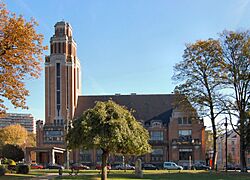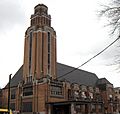Forest, Belgium facts for kids
Quick facts for kids
Forest
|
|||
|---|---|---|---|

Forest's Municipal Hall
|
|||
|
|||
| Country | Belgium | ||
| Community | Flemish Community French Community |
||
| Region | Brussels | ||
| Arrondissement | Brussels-Capital | ||
| Area | |||
| • Total | 6.25 km2 (2.41 sq mi) | ||
| Population
(2018-01-01)Lua error in Module:Wd at line 1575: attempt to index field 'wikibase' (a nil value).
|
|||
| • Total | Lua error in Module:Wd at line 1,575: attempt to index field 'wikibase' (a nil value). | ||
| Postal codes |
1190
|
||
| Area codes | 02 | ||
| Website | forest.irisnet.be | ||
Forest (in French) or Vorst (in Dutch) is one of the 19 towns in the Brussels-Capital Region of Belgium. It is located in the southern part of this region. Forest shares its borders with other towns like Anderlecht, Ixelles, Uccle, and Saint-Gilles. It also borders Drogenbos, a town in the Flemish region. Like all towns in Brussels, Forest is officially bilingual, meaning both French and Dutch are spoken.
As of January 1, 2022, about 56,616 people lived in Forest. The town covers an area of 6.29 square kilometers (about 2.43 square miles). This means there are about 8,998 people living in each square kilometer.
Forest is well-known for the Forest National/Vorst Nationaal concert hall, where many famous artists perform. It also has a large prison, an Audi car factory, and a railway depot. This depot is where the Belgian Eurostar trains are kept.
Contents
What's in a Name? The Etymology of Forest
Have you ever wondered where the name Forest comes from? The first people who lived here called their village Vorst. This name probably came from an old Dutch word, Vorstbosch. This word meant "forest" (bosch) of the "prince" (vorst).
This name likely came from the Latin phrase forestem silvam. This phrase meant "private forest." This is also why the French name, Forest, is different from the original Dutch name, Vorst. While most other towns in Brussels kept their Dutch-sounding names in French, Vorst was translated to Forest. This translation probably came from the Latin idea of a "private forest."
A Look Back: The History of Forest
Forest has a long and interesting history, going back many centuries.
How Did Forest Begin? Frankish Origins
The very first houses in this area were built around the 7th century. This was a very forested place, located along a small stream called the Geleysbeek. This stream flows into the Senne River. The first church in the village was dedicated to a saint named Dionysius the Areopagite.
A famous local story is about Saint Alena. She was a young Christian who was killed by her father's soldiers in the 7th century. This happened because she went to mass at the church of Dionysius. However, the chapel and the worship of Saint Alena only started in the 12th century. You can still see her special tomb, called a cenotaph, in the chapel today. It is one of the few examples of 12th-century sculptures left in Belgium. Around the same time, the Church of St. Denis, next to the chapel, was rebuilt in the Romanesque style.
The Medieval Period and Forest Abbey
In 1105, the bishop of Cambrai gave the parish of Forest to the abbots of Affligem. These abbots decided to build a priory for women in Forest. This became known as Forest Abbey. The first leader of the Forest priory, called an abbess, was chosen in 1239.
Also in the 13th century, the Romanesque Church of St. Denis was rebuilt. This time, it was built in the newer Gothic style, which was very popular then. The church next to the Abbey was rebuilt in the 15th century.
From the 17th Century to Today
Forest grew and became more successful during the 17th century. This was especially true when Archdukes Albert and Isabella ruled the Austrian Netherlands. The Abbey played a big part in this success.
However, on March 26, 1764, a terrible fire damaged some of the Abbey buildings. Many valuable artworks were also destroyed. About 30 years later, after the French Revolution, the religious community was forced to leave. The buildings were then sold. Luckily, the town of Forest bought the Abbey in 1964. They then worked to restore it to its original beauty.
What to See: Main Sights in Forest
Forest has many interesting places to visit, from old churches to modern art centers.
- The Church of St. Denis and the Chapel of St. Alena are very old. They have special Romanesque sculptures that you can still see. The Benedictine abbey nearby is now a cultural center.
- The Art Deco Municipal Hall is a beautiful building. It was built in 1925 and officially opened in 1938. You can find it close to the old part of town.
- The Church of St. Augustine is another Art Deco building. It is located on a square called Place de l'Altitude Cent (or Hoogte Honderdplein in Dutch). This name means "Hundred Metre Height Square" because it is 100 meters above sea level.
- The Wiels contemporary art center is a cool place to see modern art. It is located in an old brewery building that used to belong to Wielemans-Ceuppens.
- Villa Beau-Site is a great example of Art Nouveau in Brussels architecture. It has a very unique and striking design.
- Forest also has several lovely green spaces. These include Duden Park and the Forest/Vorst Park, which is named after the town itself.
Fun Times: Events and Folklore
Forest is a lively place with exciting events and unique traditions.
- The Forest National/Vorst Nationaal concert hall is very famous. Many international music stars and performers come here to put on shows.
- Every September, a three-day "Medieval Celebration" is held on the grounds of Forest Abbey. People dress up as knights, townspeople, soldiers, and other medieval characters. You can watch magicians, jugglers, and fire-eaters. You can also listen to musicians playing old instruments, see old crafts, and try forgotten foods and drinks.
- Since 1987, Forest has its own giant puppets. Their names are Nele and Pauline, and they were "baptized" at the Abbey. They also have two puppet children named Alida and Paville.
Famous People from Forest
Many interesting people have lived in Forest over the years.
- Jean Delville (1867–1953) was a symbolist painter and writer.
- Raymond Goethals (1921–2004) was a well-known football coach.
- Stuart Merrill (1863–1915) was an American symbolist poet.
- Louise Ochsé (1884–1944) was a talented sculptor.
- Paul Vanden Boeynants (1919–2001) was a politician who served as Prime Minister.
- Eugène Ysaÿe (1858–1931) was a brilliant violinist, composer, and conductor.
Forest Around the World: Twin Towns
Forest is connected to another town in the world through a special partnership called "twinning."
- Forest is twinned with Courbevoie, which is in France.
Images for kids
See also
 In Spanish: Forest (Bélgica) para niños
In Spanish: Forest (Bélgica) para niños










